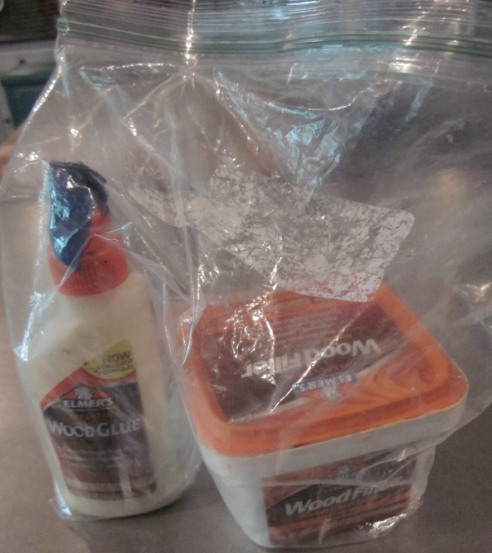Using wood filler to repair furniture that’s damaged is easy and effective. It’s also something that should be done prior to ever painting a piece of wood furniture. Today I’d like to show you how using wood filler to repair furniture and make it like new again.
Carpenter’s Wood Filler
Painting older pieces of furniture is much more than a can of paint and a paint brush. Almost every piece of pre-owned furniture I refinish requires some sort of repair to the wood or veneer prior to ever picking up a brush. That’s where wood filler comes into play.
Wood filler is a soft, putty-like material that’s used to fill holes in wood. Once exposed to air, the putty dries to a solid form that can be sanded smooth to blend in with the wood surface and then painted. Over time, it resists shrinking and cracking.
Elmer’s Wood Filler happens to be the brand I choose to repair furniture. It’s always perfeormed well and held up well over time. Elmer’s Wood Filler comes in plastic tub. Once the tub is opened, it does not seal air-tight and will harden; so you should store it in a plastic ziplock bag to dramatically extend the life of the soft putty. If make it last even longer, double-bag it or store it in a sealed plastic container.
Repair Broken or Missing Veneer
Wood filler can be used for many different types of wood repair. The first is broken or missing veneer.
Using a flat putty knife, spread the putty over the damaged area. Don’t worry about making the putty flush with the surface at this point – you actually want to apply a little more than what’s actually needed because the putty will settle.
Let the putty dry overnight and then sand the surface smooth with sand paper. Apply a second coat of the soft putty, if needed, let let dry overnight and sand again. Prime and paint the furniture as usual.
As you can see, if the wood filler is sanded to a smooth finish, once the paint is applied, you cannot even tell where the wood was patched.
Fill Large Holes in Wood
The second use for wood filler is to fill large holes.
This pedestal table used to be be an extendable table. The insert leafs were missing so I decided to permanently secure the base to the tabletop. Once the screws were in place and the table could no longer extend, there was no point in leaving the large crack that ran down the center. Two applications of wood filler later and the unsightly crack disappeared.
Fill Small Holes After Priming
The third use for wood filler is to fill small holes after priming.
Once the first coat of primer is painted on a piece of wood furniture, you will see small dents and dings in the wood that weren’t as visible prior. I always inspect a piece after it’s primed and fill the small holes.
Repair Broken Moding & Trim
Finally, one of my favorite uses for wood filler… repairing broken moldings and trim.
By no means am I a carpenter so re-creating an old molding without the proper equipment and bits would be nearly impossible. There’s always the option of removing the molding entirely, but in the instance of this six-foot long dresser replacing the molding could get costly. The molding went across the front and wrapped around the two sides. In addition, I’ve learned that ripping wood or veneer off of a piece of furniture can cause even more damage.
The easier solution is to re-build the damaged molding with wood filler.
This is where you need to channel your inner pottery skills. Apply the wood filler and very gently shape it. Allow to dry overnight, sand, and then apply a second coat if needed. Once painted, you’ll barely be able to tell there was ever such extensive damage.
On the dresser pictured below, there were entire sections missing of the decorative scroll that runs along the bottom of this cedar chest. Using wood filler, I re-built the missing sections of decorative trim.
Using wood filler to repair furniture can save a beautful piece of furniture.
If you’d like to furnish your home for pennies, subscribe to Entri Ways via email.
You’ll receive FREE, immediate access to my newest ebook:
(Click the image to subscribe & get the FREE ebook)
















Leave a Reply